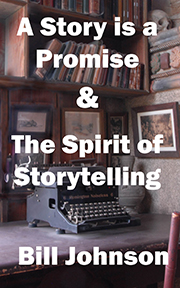| A Story is a Promise |
|
|
| Essays on the Craft of Writing |
|
|
| About the Author |
|
Vita Film Scripts Q/A |
Characters and Story

by Bill Johnson
|
|
Dynamic characters promise to take a story's audience on a journey. The key issue to understand is that it is because characters in stories act out to resolution and fulfillment issues of human need that they engage the attention of an audience. When introducing a story's characters, then, writers need to suggest in some way that their characters are "ripe." By that I mean a character has issues that arise from a story's promise.
For example, if courage is the main issue in a story, the storyteller can set a character into an environment designed to compel them to act. That's how a story's promise is made visible. It establishes both why characters act and why a story's audience should care.
Viewers want to care, to believe in the possibility of what a story's characters can accomplish. In that way they experience that belief in themselves. That's why a storyteller often arranges a story's elements to deliberately beat down and place characters in great danger, so the story's readers can more powerfully experience their rising up unconquered. Just as we secretly imagine ourselves, standing in their shoes, doing as well.
For example, in Romeo and Juliet, Romeo and Juliet are designed to be strong-willed characters in love with the idea of love. They are characters who refuse to allow anything, even death, to be obstacles to their love proving itself. By their actions, they bring this story about love to life in a way readers have enjoyed for centuries. Because their actions arise from the story's dramatic purpose, they manifest the story's movement to fulfillment.
Once the storyteller understands the role their characters serve for an audience, they can better perceive why such characters should be introduced in a particular manner:
In a way an audience can understand and identify with a particular character and their goals.
In a way that the audience is led to care about the outcome of a character's goals and issues while also perceiving how they advance the story toward its resolution and fulfillment.
That's why it's important a storyteller introduce characters in a way that allows an audience the time to take in who the characters are and what issues they have to resolve. Often this can be done simply by limiting the number of characters introduced in a scene. Many popular movies, for example, have only one or two main characters in a scene. Large group scenes are the exception, not the rule. The purpose of this is so the audience can clearly identify with an understand a character's issues.
Second, the actions of a story's characters should advance a story toward its resolution and fulfillment along its story and plot lines in a discernible way. If characters serve no dramatic purpose in a scene -- if their actions don't serve to advance the story -- save their introduction for a later time.
Characters in a story should be designed by the storyteller to have emotions that suggest how they will react to a story's events. In a story about courage, characters might confront their feelings about lacking courage. That's the internal side of the equation. The storyteller then puts them into an environment that compels them to react. By how they react, they set out the story's dramatic purpose and give voice to their feelings and concerns as the action of the story exerts pressure on them. By resolving questions based on the inner conflicts of characters, a story has meaning to those in the audience with similar feelings and issues.
Story events that have no real effect on a character's inner feelings -- a character's sense of mattering -- serve no purpose in a story. Worse, they can confuse an audience. They see characters with certain issues reacting to events that don't clearly elicit those responses. Or that elicit responses that seem out of sync with what they know about a character. Or a character's issues have been kept hidden in a way the audience has no way to feel engaged over how or why characters are responding to a story's events.
The deeper issue here is that the storyteller have a sense of how the types of characters that populate a story arise from a story's dramatic purpose. That their emotions arise from setting out that purpose. That the events of the story clearly compel those characters to respond based on a sense of who they are. That all of these are blended together to recreate a story's journey along its story line from its introduction to its fulfillment.
Well-told stories populated with dynamic, dramatic characters with larger than life passions and needs act out issues those in the audience might struggle with. Such characters battling with other determined characters to shape a story's course and outcome bring a story's dramatic purpose to life in a fulfilling way.
Creating such characters is another art in the craft of storytelling.
Top of page
